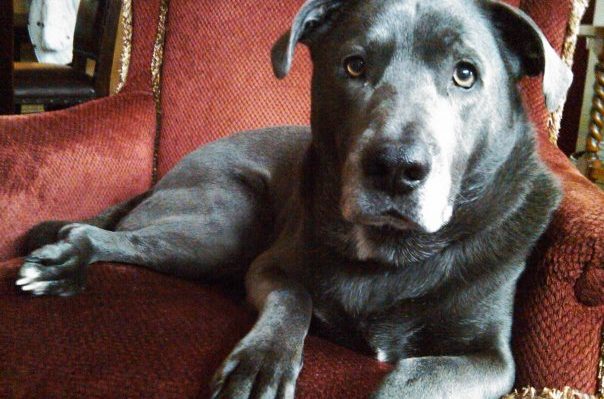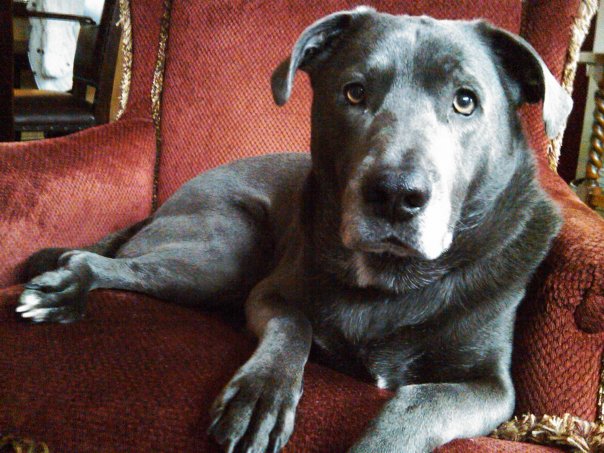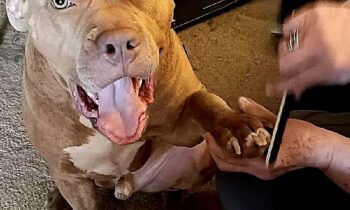
Don’t be a butthead with other dogs.
You may never have had a bad experience in your whole life. People and other dogs may always have been good to you.
That’s not true for all dogs, buddy. That’s not even true for most dogs.
Don’t expect the dogs you meet to welcome your rude behavior. They won’t. They will think you’re an idiot, or impaired, or dangerous. Possibly all three.
You will not make friends with that behavior. You might frighten them. You can’t predict what they’ll do when they’re frightened—fight, flight, freeze—but take my word, it’s not going to be good. You might get hurt.
You must learn to be more subtle—to use more tact, less bluster. You do not go straight to the sniff. You do not go straight to any part of that other dog.
You stay back and signal your own harmlessness. You let your body say, “I’m no threat” to the other dog the best you can. The other dog has teeth, too, and your goal is to stay safe.
Humans don’t help when they let you drag them on a leash so you can “socialize” with any canine you take a hankering to run up on. That tight leash makes you look more aggressive!
Humans can help by teaching you that walking on a loose leash is the most rewarding choice you can make.
Don’t run up on other dogs, ever. Even when you’re walking and they’re inside a fence. Humans may think the fence makes the meeting of two dogs who don’t know each other safe, but you know what?
Fences have gates, and gates are often left open by mistake. Fences can be dug under; fences can be jumped over.
Rehearse your horrible behavior with a dog inside a fence every day you pass that yard and one day when the dog is loose, see what happens to you. It could get ugly.
Stay back from the fence and walk on by.

Photo by Amy Suggars
And don’t be fooled by “invisible” fences, either. You may think a dog is never going to come farther than those little white flags in his front yard because that dog never has. You could be wrong.
Humans don’t help because they, too, believe invisible fences keep dogs safe on both sides of the boundary. That simply isn’t true. Dogs can learn to tolerate—even to like—the zap they get when they cross the invisible boundary to be free outside their yard. There’s really nothing stopping them, you know. Don’t be the dog who’s so obnoxious within a few feet of a dog inside an invisible fence that the IF dog breaks through the boundary, takes the zap, and barrels toward you with bad intentions.
Humans can help, very simply, by not walking you near yards that they know have invisible fencing. If your human unexpectedly encounters an IF’d yard with a dog or dogs inside the boundary, you can help . . . by not dancing on the end of your leash, by not whining or barking, by not making a target of yourself.
In other words, don’t ask for it, buddy, because you might get it and it won’t be fun.
Outdoors or indoors, don’t run up to dogs in enclosed spaces with no exits—inside cars, kennel runs, exercise pens, crates, behind baby gates, dogs on the other side of screen doors.
Don’t stand there with your muzzle pressed against the metal, either. The other dog has no escape! And after such a ridiculous performance on your part, the other dog is not likely to see you as safe. You’re not.
Don’t tailgate in close quarters, like narrow sidewalks or halls, gates, or doorways. Don’t push your way past other dogs to get through first. Don’t shove your nose up that other dog’s behind just because his head (and teeth) are pointed in the other direction.
Stay back, give other dogs space, be cool and calm. Interact later when there’s more room to breathe and space to share.
Don’t think every treat is for you!
You see a human offering a dog a treat and you rush to grab the treat? You’re in for a lot of grief, little buddy, if that other dog is not a truly tolerant soul. In fact, you may also get bawled out by that dog’s human, especially if your treat-grabbing teeth have nicked that human’s fingers!
Don’t go for treats or anything edible that’s not offered to you, with any other dogs well out of the way.
Don’t think every toy is for you!
You see a human throwing a ball and you lunge after it, knocking your human to their knees? Who’s going to feed you while your human’s in the hospital, huh?
It’s never wise to compete with another dog for just one of anything—treat, toy, or human—unless that dog is already your good friend and you both know what to expect from each other. Best-case scenario? You and the other dog reach the ball at the same time and knock your heads together. Worst-case scenario? The other dog takes umbrage at your uninvited intervention and bites you, then retrieves the thrown ball.
Don’t think every human is for you!
You see all humans as yours, to do with as you like, however you choose to interact.
Not so, dude. You don’t get to act like a WWF wrestler tag-teaming grandma, you don’t get to knock the toddler down the stairs, you don’t get to disrupt a family picnic you pass while walking through the park.
Humans may tolerate your rude behavior better than dogs will, but there are limits to what even humans will tolerate from dogs they don’t know. Once the authorities are called, you’ve got a record.
Don’t think every other dog is for you!
THIS.
I want you to stay safe, buddy. I want you to live long and prosper. You are not going to be happy and healthy for as long as you should be if you can’t overcome your entitled attitude.
I know it’s not your fault. I realize you don’t know any better. That’s why I’m giving this advice.
Don’t push yourself on other dogs or on people, even if your intentions are good. Your behavior isn’t, and that’s what counts.
You are not the center of the universe. (Except maybe for your own family.)
Humans don’t help when they tolerate your poor behavior, especially when they’re unable or unwilling to see how adversely it affects others, both dogs and humans.
Humans make it worse when they suddenly punish you for behavior they’ve unwittingly encouraged by allowing it instead of choosing to teach you a more acceptable way to behave that can, in turn, be far more rewarding to you.
Humans could learn more about how and why dogs behave because that would help them understand you and why you do what you do.
Humans can help by giving you the chance to practice proper behavior around other dogs and humans at positive training classes led by experienced, ethical instructors.
It’s not all up to you, buddy. Your behavior is really your humans’ responsibility.
You can help them to help you by being patient and attentive when they work with you. Teach them while they teach you! As one very wise human once said, “Do the best you can until you know better. Then when you know better, do better.”
That’s “don’t be a butthead” in much more eloquent words!



